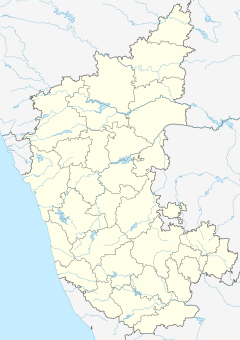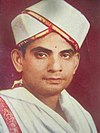Dharmasthala Temple
| Dharmasthala Temple | |
|---|---|
 The entrance of Dharmasthala Manjunatha Temple | |
 Location in Karnataka | |
| Geography | |
| Coordinates | 12°57′36″N 75°22′42″E / 12.96012°N 75.37836°E / 12.96012; 75.37836Coordinates: 12°57′36″N 75°22′42″E / 12.96012°N 75.37836°E / 12.96012; 75.37836 |
| Country | |
| State | Karnataka |
| District | Dakshina Kannada |
| Locale | Dharmasthala |
| Culture | |
| Sanctum | Mañjunatha (Shiva) & Chandraprabhu |
| Major festivals | Maha Shivaratri, Mahamastakabhisheka, Laksha Deepa Utsava |
| History | |
| Date built | 1200 C.E. |
| Creator | Birmanna Pergade |
| Website | www.shridharmasthala.org |
Dharmasthala Temple (Kannada/Tulu:ಶ್ರೀ ಕ್ಷೇತ್ರ ಧರ್ಮಸ್ಥಳ) (Sanskrit: क्षेत्र धर्मस्थल Kṣētra Dharmasthala) is an 800-year-old[1] religious institution in the temple town of Dharmasthala in Dakshina Kannada, Karnataka, India. The deities of the temple are Shiva, who is referred to as Mañjunatha, Ammanavaru, the tirthankara Chandraprabha and the protective gods of Jainism, Kalarahu, Kalarkayi, Kumarasvami and Kanyakumari. The temple is considered unique[2] since it belongs to the Shaiva sect of Hinduism. The priests are Shivalli Brahmins, who are Vaishnava, and the administration is run by a Jain Bunt family called the Pergades.
Contents
1 Legend and origin
2 Pergade family
3 References
4 External links
Legend and origin
800 years ago, Dharmasthala was known as Kuduma in Mallarmadi, then a village in Belthangady. Here lived the Jain Bunt chieftain Birmanna Pergade and his wife Ammu Ballalthi in a house called Nelliadi Beedu. According to the legend, the guardian angels of Dharma assumed human forms and arrived at Pergade's abode in search of a place where Dharma was being practised and could be continued and propagated. As was their habit, the couple hosted these illustrious visitors with all their wherewithal and great respect. Pleased by their sincerity and generosity, that night the Dharma Daivas appeared in the dreams of Pergade. They explained the purpose of their visit to him and instructed him to vacate his house for the worship of the Daivas and dedicate his life to the propagation of Dharma. Asking no questions, the Pergade built himself another house and began worshiping the Daivas at Nelliadi Beedu.
This worship of daivas continues. The Dharma Daivas again appeared before Pergade to build separate shrines to consecrate the four Daivas — Kalarahu, Kalarkayi, Kumaraswamy and Kanyakumari. Also, Pergade was instructed to choose two persons of noble birth to act as the Daivas' oracles and four worthy persons to assist Pergade in his duties as the executive head of the shrines. In return, the Daivas promised Pergade protection for his family, abundance of charity and renowned for the 'Kshetra'. Pergade, as desired, built the shrines and invited Brahmin priests to perform the rituals. These priests requested Pergade to install a Shivalinga beside the native Daivas. The Daivas then sent their vassal Annappa Swamy to procure the linga of Shiva from Kadri Manjunath Temple, near Mangalore. Subsequently, the Manjunatha temple was built around the linga.[2]
Pergade family

Chandranatha basadi in Dharmasthala

Bhagavan Baahubali statute,Dharmasthala

Gateway of Dharmasthala
The Pergade family is a Jain Bunt family who descend from the creator of the temple. Birmanna Pergade and his wife Ammu Ballalthi and are the hereditary trustees of the temple. The eldest male member assumes the position of Dharma Adhikari (chief administrator) and uses the title Heggade. The Heggade was the feudal lord of the temple town and solved civil or criminal disputes. This was a judicial function and continues even to this day: The Heggade sits in judgement on hundreds of civil complaints, known as hoyulu, each day.[1] About nearly twenty generations of the Pergade family have assumed the position of Dharma Adhikari. The present Dharma Adhikari is Veerendra Heggade. The list of previous Dharma Adhikari is as follows:[2][3]
| Dharma Adhikari number | Name | From | To | |
|---|---|---|---|---|
| 1 | Varmanna Heggade (Bermanna Pergade) | |||
| 2 | Padmayya Heggade | |||
| 3 | Chandayya Heggade I | |||
| 4 | Devaraja Heggade | |||
| 5 | Manjayya Heggade I | |||
| 6 | Jinappa Heggade | |||
| 7 | Chandayya Heggade II | |||
| 8 | Devapparaja Heggade | |||
| 9 | Anantayya Heggade | |||
| 10 | Vrsabhayya Heggade | |||
| 11 | Gummanna Heggade | |||
| 12 | Varadayya Heggade | |||
| 13 | Chandayya Heggade III | |||
| 14 | Kumarayya Heggade | |||
| 15 | Chandayya Heggade IV | |||
| 16 | Manjayya Heggade II | |||
| 17 | Dharmapala Heggade | |||
| 18 |  | Chandayya Heggade V | 1918 C.E. | |
| 19 |  | Manjayya Heggade III | 1918 C.E. | 1955 C.E. |
| 20 |  | Ratnavarma Heggade | 1955 C.E. | 1968 C.E. |
| 21 |  | Veerendra Heggade | 1968 C.E. | Present |
References
^ ab David, Stephen. "Heavenly Post". India Today. Retrieved 17 June 2002..mw-parser-output cite.citation{font-style:inherit}.mw-parser-output q{quotes:"""""""'""'"}.mw-parser-output code.cs1-code{color:inherit;background:inherit;border:inherit;padding:inherit}.mw-parser-output .cs1-lock-free a{background:url("//upload.wikimedia.org/wikipedia/commons/thumb/6/65/Lock-green.svg/9px-Lock-green.svg.png")no-repeat;background-position:right .1em center}.mw-parser-output .cs1-lock-limited a,.mw-parser-output .cs1-lock-registration a{background:url("//upload.wikimedia.org/wikipedia/commons/thumb/d/d6/Lock-gray-alt-2.svg/9px-Lock-gray-alt-2.svg.png")no-repeat;background-position:right .1em center}.mw-parser-output .cs1-lock-subscription a{background:url("//upload.wikimedia.org/wikipedia/commons/thumb/a/aa/Lock-red-alt-2.svg/9px-Lock-red-alt-2.svg.png")no-repeat;background-position:right .1em center}.mw-parser-output .cs1-subscription,.mw-parser-output .cs1-registration{color:#555}.mw-parser-output .cs1-subscription span,.mw-parser-output .cs1-registration span{border-bottom:1px dotted;cursor:help}.mw-parser-output .cs1-hidden-error{display:none;font-size:100%}.mw-parser-output .cs1-visible-error{font-size:100%}.mw-parser-output .cs1-subscription,.mw-parser-output .cs1-registration,.mw-parser-output .cs1-format{font-size:95%}.mw-parser-output .cs1-kern-left,.mw-parser-output .cs1-kern-wl-left{padding-left:0.2em}.mw-parser-output .cs1-kern-right,.mw-parser-output .cs1-kern-wl-right{padding-right:0.2em}
^ abc Long, Roger D; Wolpert, Stanley A. (2004). Charisma and Commitment in South Asian History. Orient Blackswan. ISBN 978-81-250-2641-9.
^ B. N. Hebbar (2005). The Śrī-Kṛṣṇa Temple at Uḍupi: the historical and spiritual center of the Madhvite sect of Hinduism. Bharatiya Granth Niketan. pp. 83–84. ISBN 978-81-89211-04-2.
External links
| Wikimedia Commons has media related to Dharmasthala Temple. |
- Official website of Dharmasthala Manjunatha Temple
